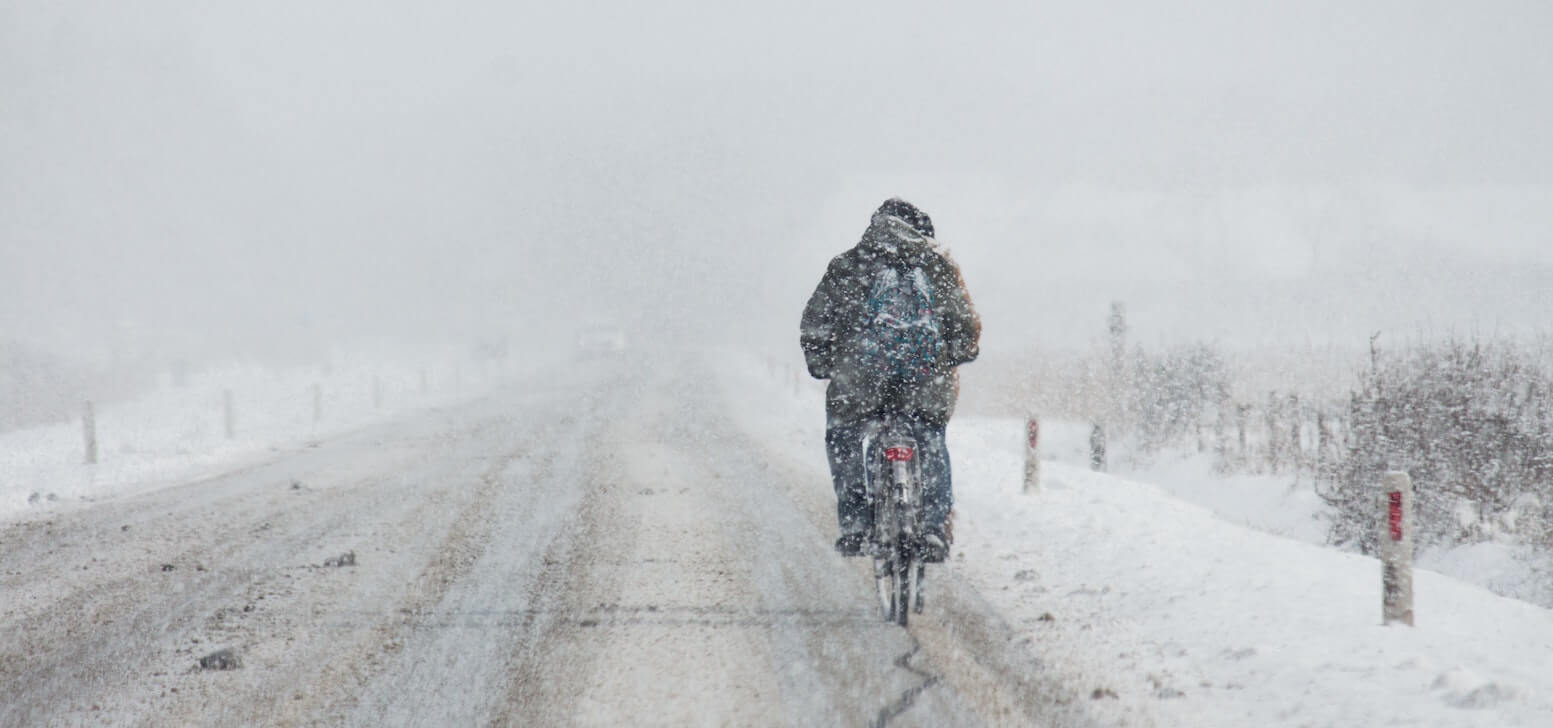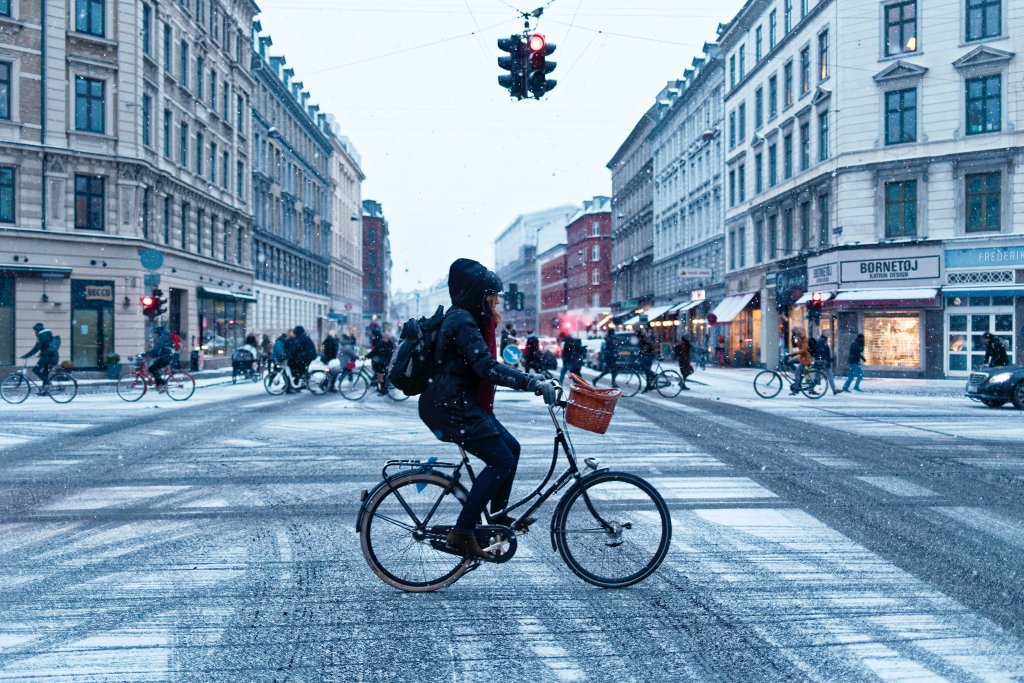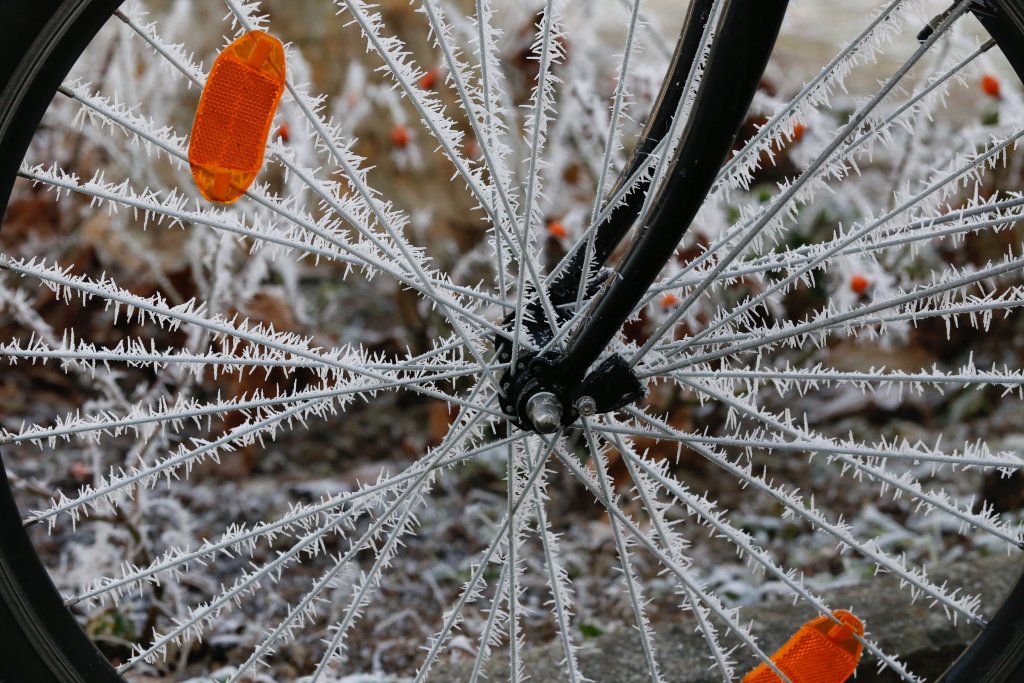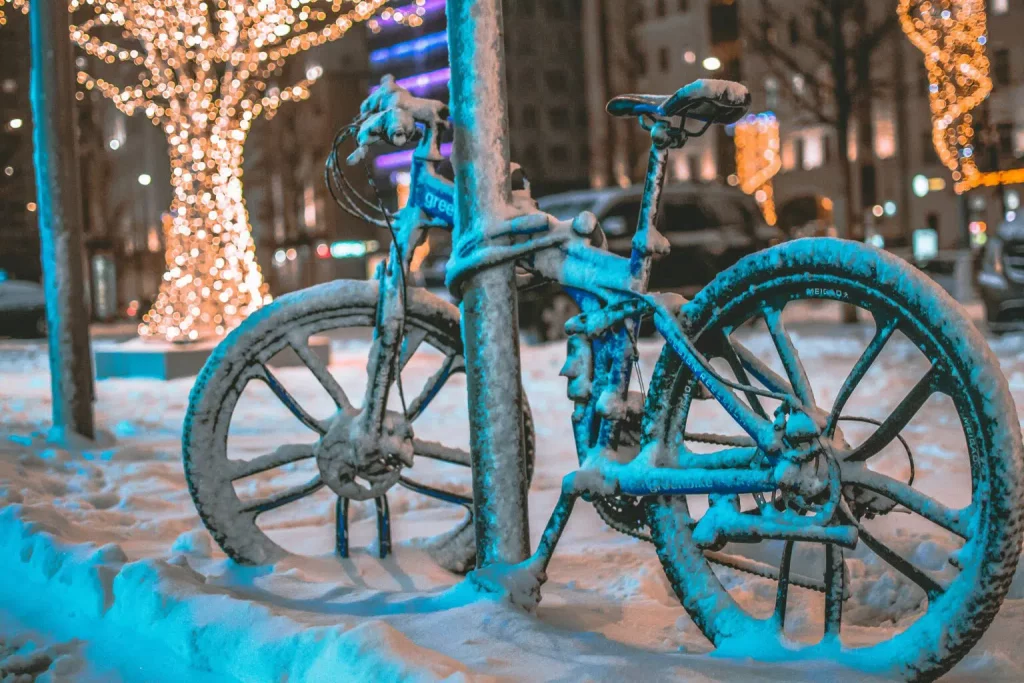Your Winter Cycling Guide
Cycling in winter comes with a whole set of challenges. Our tips will help you handle them a little better.

Cycling in winter comes with a whole set of challenges. Our tips will help you handle them a little better.

Some people think bike riding is only for the warmer months. You’re not one of those people.
This winter, you’re committed to cycling, despite the cold, the rain, and the other less-than-ideal conditions. Nothing can stop you from getting in the saddle.
Winter riding isn’t for everyone, as it comes with its own unique set of challenges. We’ll break down best winter cycling techniques, and the appropriate dress-code to make life on the bike a little easier this winter.
The best part? We’ll include some precious bike wisdom gifted to us from our our team members based in Amsterdam. They’re bad weather pros who prefer cycling to other forms of transportation on any—and we mean any—day of the year.

The right wheels for the occasion
First stop: your tires. They’re the part of your bike that’s the most exposed to slippery, icy, or bumpy conditions. Depending on the type of tires you’re using, and the condition they’re in, your ride can be either a fun, brisk outing… or a near-death experience.
Not surprisingly, your typical road bike, which usually comes with thin tires and a smooth tread, is less than ideal for fall and winter weather. According to Lemonader Artem R., you should avoid cycling on icy streets altogether if your tires don’t have any tread pattern. If you’re the proud owner of a mountain bike, however, with its wide tires and pronounced tread, you’re already better equipped for cold weather.
Another pro tip from the website of Stadler’s (‘Germany’s biggest cycling-center’): Release some air from your bike tires. With your tire a bit flatter, you’ll have more surface area in touch with the ground. Careful though—make sure the tire pressure is still at the minimum recommended by your bike’s manufacturer.
Studded bike tires for the ultimate experience
If the weather’s rough where you live—we’re talking lots of snow and ice—you might want to consider getting some specialized winter bike tires (yes, they’re actually a thing!). But make sure the wider winter tires fit your bike’s frame and wheel rims. Do a quick Google search to check which kind of winter tires will work with your frame, and peruse the selection at a trusted bike shop (they’ll be able to install them for you).
Generally, winter bicycle tires can be divided into two categories: tires that simply have a more pronounced tread than the average, and tires that have “spikes” in addition to the more pronounced tread. These spikes are small metal pins that drill into the ground as you ride to give you extra grip.
One thing to keep in mind: Before you can use studded tires in more difficult terrain, they’ll need to be broken in for at least 20 miles on asphalt, according to German sustainability platform Utopia.
Muddy waters
Now that we’ve sorted out the tires, let’s move on up to your bike’s mudguard. If it’s raining or snowing, this handy device will protect you (and your clothes) from water and mud spraying up your back as you ride. A mudguard doesn’t only protect you, it also protects other cyclists riding behind you.
To enjoy maximum protection, the mudguard should be placed on top of both your front and back tires. If you’d like to be extra safe and dry, or if you can’t install a regular mudguard on your bike, Lemonader Ron V. recommends using an add-on called, wait for it, the ‘Ass Saver’. It’s a lightweight mudguard that attaches easily to your bicycle’s seat post.
Bike lights and reflectors
In most states and cities, having quality lights on your bicycle is required by law. You’ll want to make sure your bike is equipped with a white front light and a red rear light. In New York, for instance, your front light needs to be visible from a distance of at least 500 feet, while the rear light needs to be visible from at least 300 feet. This is the case in many other states as well.

Lights will come in handy during the daytime if it’s raining or snowing, or if conditions are hazy. And if you’re considering cruising around without lights at night, whatever the weather? You’re playing roulette with your life.
There are fewer laws requiring reflectors. They’re worth having though, since they’ll significantly increase your visibility, and therefore, your safety.
To really make sure passing cars and pedestrians see you coming, put a reflective vest on top of your cycling clothes. It adds an extra layer to protect you from biting winds. And it can be chic if you wear it with the right attitude, we promise.
If an array of lights isn’t enough to let everyone know you’re rolling through, Lemonader Elske H. suggests installing a loud high quality bell on your bicycle. A bell becomes especially important if weather conditions are bad and your vision is compromised due to rain, snow, or wind.
Show your bike some love
It’s crucial to take care of your bike both before and after setting off on a ride, according to Lemonader Ron V.
“There’s a lot of dirt and salt on the roads, which might simply kill your bike,” he says. “Treat it nicely.”
Ride slowly, & keep your distance.
Okay, let’s start with the obvious. If you think the roads or bike paths could be slippery, slow your roll. You’ll be able to react to obstacles more quickly. In addition, we’d recommend keeping a greater distance between you and other cyclists and pedestrians, so if you or someone else loses control, you’ll have enough time to get out of the way safely.
Keep braking and steering to a minimum.
Avoid extreme steering movements and reduce steering to a bare minimum when the ground is icy or covered in snow. It could be the difference between smooth sailing and a painful wipeout.
The same applies to braking. If the street is slippery due to wet leaves or patches of ice, avoid heavy or abrupt braking. Consider coasting to a stop, if you can, rather than jamming on the brakes.
Adjust your saddle height
The German Cycling Association recommends that while riding in the winter, you might want to lower your bicycle seat. That way, it’ll be easier to touch the ground with your feet if you need to.
However, don’t forget to readjust the seat to its original position once the weather clears—otherwise you might do damage to your knees.
The proper breathing technique for cycling
Sports physician and health expert Dr. Piero Lercher recommends that when cycling in extreme cold, you should breathe in through your nose and out through your mouth (same as when you’re out on a run). This way, the air you breathe in has to travel a longer distance to reach your lungs, giving it additional time to warm up.

When riding your bike in the cold, make sure you’re as covered as possible. This especially applies to rides at high speed.
Why is a fast winter ride especially chilly? It’s all about the windchill effect. Cold wind blows away the warm layer of air that usually surrounds the surface of your skin, leaving you more exposed to the elements. However, according to German outdoor magazine Bergzeit, you’ll only feel the windchill at temperatures below 50 degrees fahrenheit (10 degrees celcius).
So what’s the ideal winter cycling uniform? Keep a few items in mind.
Layers, layers, layers
It’s a good idea to layer up; if you overheat, you’ll be able to take off a layer to get comfortable. As an outer layer, a windbreaker or soft shell cycling jacket will serve you well.
Windproof cycling gloves
Choose the right pair of water-resistant gloves that’ll keep you warm and protect you from the elements. Lemonader Max von A. swears by the Swedish brand Hestra.
A bike helmet (not optional)
Yes, a bike helmet can be clunky. It’ll mess up your hair, too. But you know what’s worse than that? Being dead.
A proper helmet is the item that guarantees your safety while cycling. However, there are special bike helmets that are designed for winter weather, like options that come with a visor, for example. Visors keep cold wind and snow off your face, making them a great accessory for speedy cycling or bike rides in stormy weather. You can also buy yourself some cycling glasses.
Some helmets also offer padded liners to keep you warmer in the winter months.
A hat that fits under that helmet
You can either wear a slim hat or a multifunctional scarf that will protect your neck from the cold, or can be worn as a headband or hat. A balaclava provides even more coverage, and has the added benefit of making you look really tough.
Cycling overshoes
If you’re faced with a lot of snow or rain, and you’re planning on getting to work with dry feet, the Lemonade team recommends cycling overshoes. These shoe covers slip on top of your regular cycling shoes to keep them dry and clean.
Your bicycle is covered by your Lemonade renters or homeowners insurance policy—more specifically, it’s protected against 16 named perils, including vandalism and bicycle theft (provided that you’ve properly locked up your bike).
If your bike is especially valuable, you’ve got the option to add scheduled personal property coverage (called Extra Coverage here at Lemonade) to your policy.
By adding Extra Coverage, your bike would be covered for everything listed under your base policy, plus additional types of damage—all without having to pay a deductible. You’re now a winter cycling safety pro, but accidents still happen. So if you slip on an icy road and crash your Bianchi into a fence, your Extra Coverage could really come in handy.
Please note: Lemonade articles and other editorial content are meant for educational purposes only, and should not be relied upon instead of professional legal, insurance or financial advice. The content of these educational articles does not alter the terms, conditions, exclusions, or limitations of policies issued by Lemonade, which differ according to your state of residence. While we regularly review previously published content to ensure it is accurate and up-to-date, there may be instances in which legal conditions or policy details have changed since publication. Any hypothetical examples used in Lemonade editorial content are purely expositional. Hypothetical examples do not alter or bind Lemonade to any application of your insurance policy to the particular facts and circumstances of any actual claim.